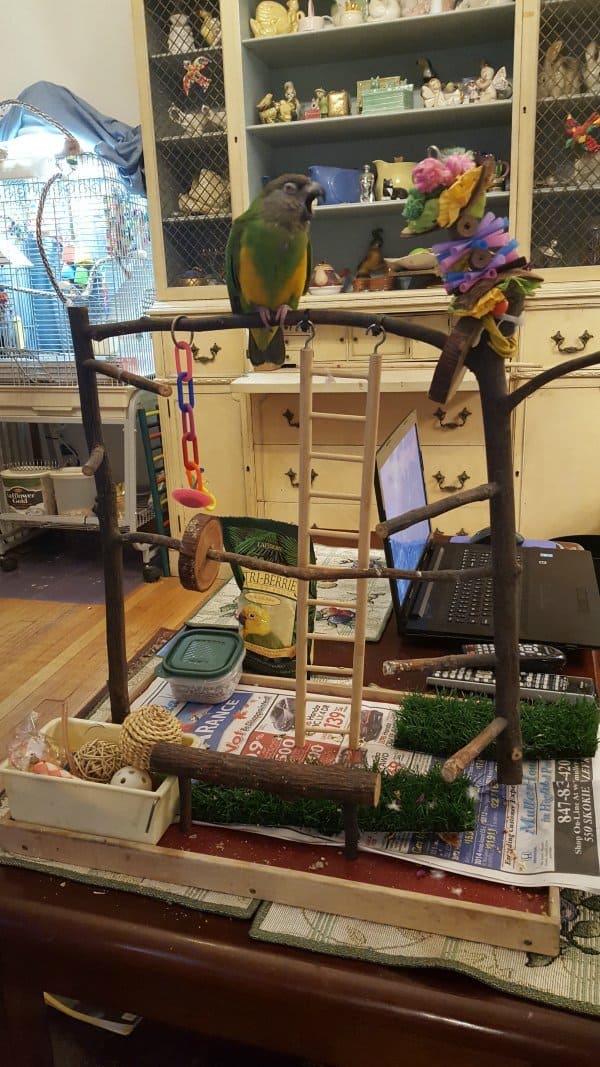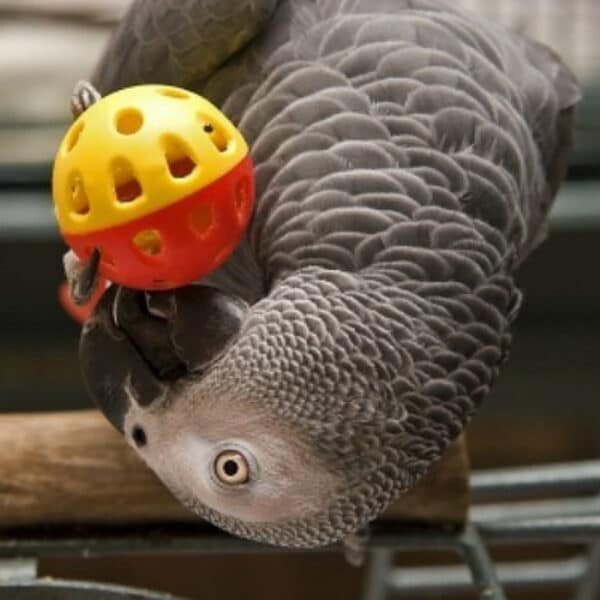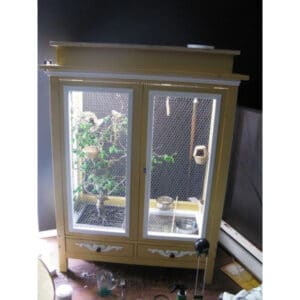Last Updated on by Mitch Rezman
A clear theme that emerges after reading endless threads on Facebook bird groups is “my bird won’t play with toys” – “my bird doesn’t play with toys” “my bird only wants to chew the keys off my notebook computer”
From Wikipedia we learn Ho·lis·tic – hōˈlistik – adjective – characterized by comprehension of the parts of something as intimately interconnected and explicable only by reference to the whole.
Another way of putting it is “we are not connecting the dots” Bird food is connected to bird toys which are connected to bird cages and bird stands and everything has to work together.
There is a large overlap of caged bird keepers who claim the birds will eat nothing new nor with a play with toys – which is the problem and the solution – we need to combine the toys with the food – for starters.
Let’s back up for a moment and define the role of toys in your bird’s lives
Foraging Enrichment – reducing or eliminating boredom by – working for food.
Privacy – using toys like the leaves of a tree in the wild in the top one-third of the cage – the cage canopy concept
Studies have shown time and time again that parrots prefer to forage for their meals rather than simply having unlimited food sources and open dishes.
Let’s say your bird is not playing nor interested in its toys and if your bird is not eating his food while not appearing interested in any new food.
This tells us we need to combine the two, toys and food. Make mealtime interesting, not five or 10 minutes eating out of the overfilled food dish and then returning to the cage top.
If your bird is not “playing” with toys try thinking of ways to attach food to said toys. You attach almost anything from millet and fruit to almost anything else using cable ties.
If you don’t have any vine balls or small toy parts, crinkle up small balls of newspaper (yes it’s safe for birds) or tissue paper, anything in that order and cover the food dish so it can’t see the food – do that for a couple of days and call me in the morning.
The other issue is birds acting indiscriminately destructive like popping off your notebook computer keys. If the bird sees you working on a computer it sees the computer as a toy and wants to work on the computer too.
If you’re searching for something to watch on Netflix, the bird wants to play with the remote (remotes contain deadly batteries).
If you’re not offering alternatives to computer keyboards and remotes expect them to be destroyed. Birds are amoral, they are not being bad – they are being birds.

There is a notebook computer behind her, three remotes next to notebook computer in front of her where I’m taking the picture, there are three more keyboards and 2 more remotes – you can see she is on a stand and quite content – at the base of the stand is a foraging box filled with toy parts and at the bottom of the box are sunflower seeds Nutri-berries, walnuts, and almonds.
She will never learn the meaning of “no” in her entire lifetime – it’s not how parrots are wired. All she wants to do is play with your toys. You need to offer alternatives when she is out of the cage.
Peaches climbs up and down all day foraging for nummies and I refill the box from the floor – all day – she has toys on the stand – the right one is missing because she chewed it off – a good thing – she climbs down there every once in a while and I will bring her over to me to pet and then re-place her on the stand.
We do this for 4 to 6 hours a day when I’m working at home or I may put her in the cage with the door open she’s not flighted yet so she cannot return to it by herself in my humble opinion your birdcage could use more toys – we feel toys in a birdcage are to birds what the leaves on the trees are to birds in the wild.
We advocate enough toys for a bird to hide behind for privacy – we call it the cage canopy concept PM me if you’d like more details
In my humble opinion, your bird’s cage could use more toys – we feel toys in a birdcage are to birds what the leaves on the trees are to birds in the wild.
Diana indicated there are not a lot of toys in the cage because the bird is out of the cage most of the day – what about the 12 hours of birdie bedtime in the cage – he asks rhetorically?
She also goes on to say that when the bird interacts with the notebook computer she puts the bird back in the cage – the one without a lot of toys in the cage. The process repeats almost daily.
Mitch Rezman replied
I made a boatload of toys after spending $12 at the dollar store – getting your bird to interact with new toys is a journey.
When I fill the foraging box I always give her a nibble and make sure she sees me adding the treats to the box.
The real problem is computers and remotes have metal – electricity and poisonous batteries – if you click on my profile – you’ll see my day gig – I’ll work with you in any way to make your experience better with your bird – thank you.
Recently adopted 10-year-old blue and gold macaw whose wings were clipped from the beginning – will he ever fly again?
Hi Jessica – we have a similar situation. We recently rescued a seven-year-old Senegal parrot whose wings had been clipped all of her life so she’s never flown.
Generally speaking, birds who do not learn how to fly immediately after fledging lose the ability to fly – or so I’m told.
Our last bird who passed away in June (cancer) – an albino cockatiel named Popcorn came to us fully flighted.
She was an escapee who got caught in some bushes about two blocks away from Windy City Parrot.
I brought her home – let her loose – she panicked and ended up behind a dresser.
We immediately clipped her wings but they started to grow back fast and about a month into the growth I began to give her “flying lessons”.
Cockatiels are like gymnasts so I started by walking a foot away from the cage and tossing her onto the cage where she grabbed the Booda perch on top.
During the ensuing weeks, I would increase my distance from the cage and then started introducing alternate landing areas throughout the house in every room so she knew exactly where to go with no confusion.
She was with us 3 1/2 years and about 90 days after we clipped her wings we began a morning ritual in which she followed me throughout the house from room to room.
We have a 62-foot long apartment. The living room and dining room are about 30 feet long divided by two large solid oak pillars.
In the morning when I opened up the cage door she would take off and do figure eights – three or four laps until she landed on her cage waiting to see what room I would go in.
Peaches our Senegal is an entirely different situation because she’s a tremendous and precise climber but she leads with her beak which is not a good way to land.
I hope you will join me on our journey to teach her, controlled flight – It’s important to note that we flight proof the house by arranging flowers in front of the lower windows and keeping the shades down and making sure she is not distracted by any mirrors Hope that helps.
Written by Mitch Rezman
Approved by Catherine Tobsing
your zygodactyl footnote
Author Profile
Latest entries
 The Traveling BirdJune 26, 2025Can You Name 5 Parrot Species That Are Living Wild in the USA?
The Traveling BirdJune 26, 2025Can You Name 5 Parrot Species That Are Living Wild in the USA? Bird BehaviorJune 26, 2025How is it Parrots Are Problem Solvers Social Animals and Even Use Tools?
Bird BehaviorJune 26, 2025How is it Parrots Are Problem Solvers Social Animals and Even Use Tools? Bird & Parrot AnatomyJune 25, 2025How a Tiny Chemical Modification Makes Parrots Nature’s Living Paintings
Bird & Parrot AnatomyJune 25, 2025How a Tiny Chemical Modification Makes Parrots Nature’s Living Paintings PigeonsJune 20, 2025How Do Parrots Thrive in Cities Outside Their Native Habitats?
PigeonsJune 20, 2025How Do Parrots Thrive in Cities Outside Their Native Habitats?



